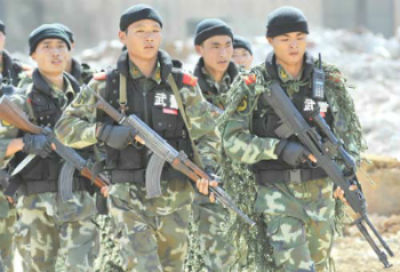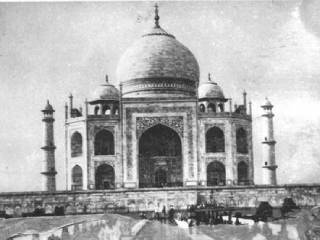Chaitra Krushnapaksha 10, Kaliyug Varsha 5115
By Appu K Soman
 |
Defence Minister AK Antony insisted a few months ago that “India of today is not the India of 1962.” He claimed that “successive Governments learning lessons from the past strengthened our capabilities and modernised our armed forces.” Antony was wrong. Successive Governments have refused to learn lessons from the past and have failed to strengthen India’s defence capabilities.
The failures that culminated in India’s humiliating defeat in 1962 are well known: Prime Minister Jawaharlal Nehru failed to provide adequately for India’s security. His Government, for years, failed to notice Chinese activity in Ladakh. Even after Nehru woke up to the China threat, the Government avoided strengthening the Himalayan defences. The Finance Ministry would not allocate adequate funds for defence. Nehru rejected Chief of Army Staff General KS Thimayya’s proposals to create specialised mountain divisions and to even prepare a manual on Chinese military tactics, out of fear that such actions might provoke China. Having failed to build up defence capabilities, the Government relied on diplomacy to manage China. By the time it learned that diplomacy from a position of weakness does not pay, it was too late.
The defeat in 1962 and the resulting public outrage led to a belated burst of activity to strengthen the defences against China. Ten mountain divisions were created at last. But growing economic troubles soon forced a cutback in defence spending. The newly built up forces required modernisation of their equipment. The India of the 1970s could not afford it.
In the early 1980s India, for the first time in its history, acted proactively to strengthen its defences. Under Operation Falcon — Army Chief of Staff General KV Krishna Rao’s plan for forward defense approved by Indira Gandhi — India began upgrading the long-neglected infrastructure along the Line of Actual Control (LAC). His successor, Gen Krishnaswamy Sundarji, initiated a programme for modernising the Army. The plan involved increasing the mobility and firepower of the mountain divisions and the forming of two air assault divisions.
Thanks to the buildup of Indian military capabilities in these years, India could face China with confidence during the Sumdorong Chu crisis of 1986-1987, the last time the two countries were in a face-off similar to the current standoff in Ladakh. The Indian Army was significantly stronger then than the one the People’s Liberation Army (PLA) had routed in 1962. The Indian Air Force was more than a match for the PLA Air Force. The IAF’s MiG-21 fighters were superior to China’s reverse-engineered copies of early version MiG-21s. Besides, the IAF had recently acquired MiG-23s, MiG-29s and Mirage-2000s. The Chinese aircrafts would have found it difficult to operate from the airbases in Tibet. The IAF, facing no such problem, would have easily won air supremacy in the theatre.
The economic downturn that began in 1988 led to the abandonment of the plan to create air-assault divisions and to the slowing down and eventual abandonment of the Rao plan and the rest of the Sundarji plan. India once again lowered its guard, leaving it to diplomacy not backed by adequate strength to deal with China.
 |
The timing of India’s defence cutbacks was unfortunate. China had started modernisation of the PLA in a big way in 1985. In January 1993, the Chinese government, learning from the lessons of the 1991 Gulf War, began to prepare the PLA to fight “local wars under high technology conditions.” China put in a stupendous effort to improve its Tibetan infrastructure, building roads, airports and a rail line all the way to the border with India. China now has the ability to overwhelm Indian forces at locations of its choosing along the LAC. China has eroded India’s advantage in the air by acquiring combat aircraft capable of operating from Tibet’s high altitude airbases. The Chinese air force recently demonstrated its enhanced capabilities by conducting live fire training exercises in the Qinghai-Tibet region.
India’s defence modernisation, halted in 1988, never really regained momentum even after the economy reached much higher levels of growth and evidence of China’s increasing capabilities mounted. Defense expenditure as a percentage of the GDP has steadily declined over the years, demonstrating the government’s unwillingness to spend adequately on national security. All three services now have serious deficiencies.
Emboldened by India’s weakness and the UPA Government’s lack of determination to defend the country’s security interests demonstrated by its weak-kneed handling of Pakistan, China once again turned the screws on India. In 2006, Beijing went back on its 2005 agreement with India to leave out areas with settled populations from territorial claims. After that, frequent Chinese intrusions into areas India claims along all sectors of the LAC began. India has responded with excessive caution. According to media reports, the fear of another embarrassing defeat at China’s hands forced the government to restrain Indian troops from patrolling up to the LAC as perceived by India in some locations. The Indo-Tibetan Border Police reportedly patrols unarmed in some sectors. Former Chief of Army Staff General Shankar Roychowdhury once commented that India’s passive response to Chinese aggressiveness has at times verged on “apparent deference.”
In 2008, finally the government decided to equip the armed forces for a two-front war. The plan included two new mountain divisions plus a mountain strike corps for counterattacks deep into Tibet. It was a fairly modest plan, given the scale of China’s buildup in Tibet. Even that plan fell victim to the UPA government’s lack of commitment to national defence. In a throwback to the 1950s, the Finance Ministry held up the proposal for the mountain strike corps. The reasons offered for the rethink are striking: (1) shortage of funds; (2) the fear of provoking China; (3) the Finance Ministry’s doubts about “the longevity of the China threat.” Meanwhile, the building of infrastructure proceeded at a snail’s pace.
It is as if an unseen hand makes sure that the Government of India periodically repeats the mistakes leading up to the 1962 defeat in exactly the same way. Hopefully, the latest crisis will have answered the Finance Ministry’s question about the longevity of the China threat. But the proclivity to avoid strengthening defences out of fear of provoking China is so deeply ingrained in official thinking that it is hard to see the government overcoming it anytime soon.
The crisis in Ladakh demonstrates that the India of today is no different from the India of 1962. A quarter century of neglect of its armed forces has left the country with no easy military option. The history of Sino-Indian negotiations leaves not a shred of hope that diplomacy will succeed this time around. The American humorist Will Rogers called diplomacy “the art of saying ‘nice doggie’ until you can find a rock.” India dispenses with looking for a rock altogether. It has made saying ‘nice doggie’ its entire national security strategy.
Source : Niti Central

 Mizoram: EC accepts Christians’ demand to defer counting on Sunday, but what if Hindus had made a similar demand?
Mizoram: EC accepts Christians’ demand to defer counting on Sunday, but what if Hindus had made a similar demand? Sign Petition : Immediately repeal the draconian and unconstitutional ‘The Waqf Act, 1995’
Sign Petition : Immediately repeal the draconian and unconstitutional ‘The Waqf Act, 1995’ Shriram : Sri Lanka’s saviour
Shriram : Sri Lanka’s saviour Why it is so cool to malign Hindu gods and goddesses, but it may not be that easy now
Why it is so cool to malign Hindu gods and goddesses, but it may not be that easy now Shocking Truth of Taj Mahal exposed by Late Pujya P. N. Oak
Shocking Truth of Taj Mahal exposed by Late Pujya P. N. Oak How are Hindus treated in states where they are in a minority?
How are Hindus treated in states where they are in a minority?